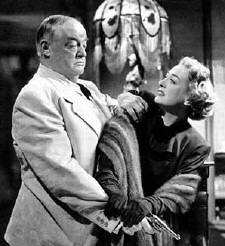

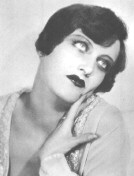
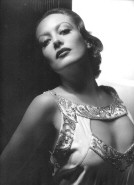




The Best of G
 Gable, Clark.
(2/1/01 - 11/16/60) The "King of Hollywood," with whom Joan co-starred in 8 films
(he was her
second-most frequent co-star, after Gwen
Lee): Dance, Fools, Dance ('31), Laughing
Sinners ('31), Possessed ('31), Dancing Lady ('33),
Chained ('34), Forsaking All Others ('34), Love
on the Run ('36), and Strange Cargo ('40).
Gable, Clark.
(2/1/01 - 11/16/60) The "King of Hollywood," with whom Joan co-starred in 8 films
(he was her
second-most frequent co-star, after Gwen
Lee): Dance, Fools, Dance ('31), Laughing
Sinners ('31), Possessed ('31), Dancing Lady ('33),
Chained ('34), Forsaking All Others ('34), Love
on the Run ('36), and Strange Cargo ('40).
The two had an on-again/off-again affair between 1931 and his death in 1960. MGM publicist James Merrick said of their relations:
I don't think sex was the main attraction, but they probably did all right in that department. Joan was an outlet for Clark; he could talk about his problems and she'd listen and offer the right comments and usually the right advice. Not that she was one of the boys, but outside of Carole [Lombard] she was the only person who really got through to him. A lot of us thought they'd marry, and I think they came close a couple of times, but it's probably a good thing they didn't. It wouldn't have worked, any more than her other marriages worked, because she was stronger than he was, and Clark knew he had an image to protect. The only time he made any detrimental comment on their relationship was when he told me that "Joan swings more balls than I do." (CWJC)
Said Joan in CWJC: Clark and I were both from middle-America, both peasants by nature, not too well-educated, and so frightened and insecure we felt sort of safe and home again when we could get together. We both had a built-in bullshit alarm system, and we were surrounded by the stuff, but the only times we could really talk about it, and laugh at what went on, was when we were together...We simply gave each other courage... Clark was a wonderful man. Very simple, actually, pretty much the way he's been painted. He was more of a womanizer than the studio wanted to admit, but any relationship he entered into was honest--no false hopes, no bullshit. He outgrew his first two wives and he felt terribly sorry for the breakups. Aside from Carole and, for different periods, me, his hunting and fishing and drinking and out-with-the-boys flings meant more to him than women. And no matter how offhand he seemed about it, his career meant more than anything else. He always worried about not having studied more, about being a personality, not an actor. This was silly, because he was a damned good actor, and it wasn't his fault that his looks and his personality dominated the screen the way they did... I still wonder what would have happened if we'd married, but I'm glad we didn't. What we had between us was so special...when he went a part of me did too, and as much as I loved Alfred [Steele, her last husband], that part was never revived.
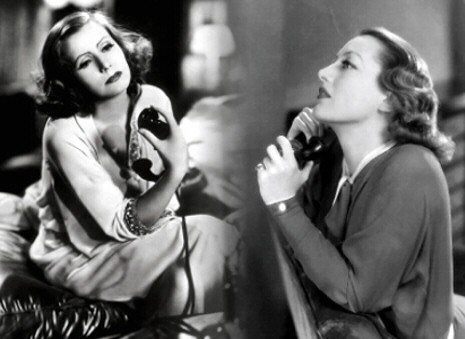 Garbo,
Greta. (9/18/1905 - 4/15/1990)
Garbo,
Greta. (9/18/1905 - 4/15/1990)
Born Greta Gustaffson to a working-class family in Stockholm, a teenaged Garbo appeared in 2 feature-length Swedish films before being discovered by MGM's Louis B. Mayer and brought to Hollywood in 1925, along with her mentor, director Mauritz Stiller (soon dumped by MGM). Her third MGM silent film, 1927's Flesh and the Devil (co-starring her longtime on/off lover John Gilbert), made her an international star, known for performances that were both sensually and spiritually evocative. From 1928 thru 1932, she was among the top money-makers for MGM and remained their highest-paid female star until her 1941 retirement from films.
Though her US domestic box-office returns fell off post-1932 (when she attempted to focus more on historical/literary personages rather than exotic vamps), she was a foreign box-office smash and a critical favorite until her retirement, garnering three Oscar nominations (1930, one nom for both Anna Christie and Romance; 1936 for Camille; and 1939 for Ninotchka), as well as NY Film Critics Circle Best Actress awards (Anna Karenina, 1935, and Camille), and National Board of Review Best Acting awards (Camille, Ninotchka, and Two-Faced Woman, 1941). In 1954, Garbo was awarded an Academy Honorary Award "for her luminous and unforgettable screen performances." In 1999, the American Film Institute ranked Garbo fifth on its list of the greatest female stars of classic Hollywood cinema.
Garbo died of pneumonia and kidney failure in Manhattan in 1990, leaving an estate worth about $66 million in 2021 dollars to her niece. Her ashes are interred in Sweden's Skogskyrkogεrden Cemetery.
Joan and Garbo co-starred in one film together, 1932's Academy Award-winning Grand Hotel, although they didn't share a single scene.
Says
Joan in Portrait of Joan:
Garbo
was my favorite actress in the world, a fascinating woman. To this
day [written in 1962] I deplore the fact that she is unable
to share herself with the world. Such a waste! If anywhere along
the line she'd been able to find a person who would have pulled
her out of her fears, she'd have continued giving such great artistry,
such joy to the world. There are those who need a leader. She did.
I never believed she was a recluse, she didn't want to be alone,
that was a publicity gag---only look how she adored Stiller, Gilbert,
Stokowski. These were strong men and she was a strong woman; if
only she hadn't been so afraid, she wouldn't today be a lonely stranger
on Fifth Avenue, fleeing before recognition, and to those who ask
about her making movies, replying, "I've said no for so long
and now it's too late." ...
In Grand Hotel I was just sad that Garbo as the renowned ballerina, Grusinskaya, and I, Flaemmchen, the little whore-stenographer, had no scene together. We frequented Grand Hotel, but in different worlds. We frequented different worlds at the studio as well. Miss Garbo worked days and left at five; I came to work at six and shot all night. One evening I was just starting to the set when she came up the stairs to her dressing room. I was with Jerry Asher and I literally shoved him into a corner and followed him into it so we would both be out of her way... There suddenly above me was that beautiful face with those compelling eyes...
As for what happened next... See this site's Live at Town Hall transcript page, where fan-girl Joan excitedly re-lives their brief encounters---the same encounters more staidly recalled in POJ. (Joan obviously had a crush on the bisexual Garbo, whose known male lovers included Gilbert, conductor Leopold Stokowski, novelist Erich Maria Remarque, photographer Cecil Beaton, and financier/Valentina-husband George Schlee; and female lovers: writer Mercedes de Acosta, actress Louise Brooks, and actress Mimi Pollak.)
[Editor's Note: In the mid-'80s in Austin, Texas, and not yet out of the closet, I worked at the campus library and was in love with Garbo's face after reading Walker's book about her. In those pre-digital days, the only Garbo films I could find around town were Anna Christie for VHS rent from a video store and Grand Hotel on VHS in my college library (where I sat upright in a very uncomfortable hard chair and watched on a tiny 12- x 8-inch screen). After seeing both, I forgot all about Garbo and was stunned by Joan in GH---but, I lectured myself, you can't keep falling in love with these dead actresses... At any rate, '87 is the year that my Joan obsession began, directly as a result of finding Garbo so terribly wooden, and Joan so vibrant and alive, in GH. So, thanks, GG, for being a gateway drug!---SJ, 2022]
findagrave.com IMDb page. TCM page. Wikipedia page.
 Gardenias.
In the 1930s, Joan made it known that this was her favorite flower, mentioning
it in interviews and wearing it conspicuously on numerous occasions.
Gardenias.
In the 1930s, Joan made it known that this was her favorite flower, mentioning
it in interviews and wearing it conspicuously on numerous occasions.
In the 1972 book The Image Makers, Joan was quoted as saying about this period:
I loved gardenias. I wore gardenias everywhere. I had great bowls of gardenias all over my house. But unfortunately Id have to throw them away about an hour
after Id put them on. They just turned brown. Nothing you can do about it. I just have too much body heat.
(The association between Joan and gardenias was strong enough that decades later, in the 1971 grand guignol film What's the Matter with Helen?, Debbie Reynolds' character receives the flower from an admirer and exclaims, "Oh, gardenias! Joan Crawford's favorite!" Also, check out Joan's 1956 movie Autumn Leaves to see a vendor selling gardenias outside a movie theater.)
Thanks to James for the book excerpt and Helen quote and to Jon for the Autumn Leaves reference.
 Garfield,
John. (3/4/13 - 5/21/52) Garfield's brief 13-year film career was
cut short when he died of a heart attack at the age of 39. The year before his
death, he'd been blacklisted for his left-wing sympathies and had refused to
testify before the House Un-American Activities Committee. Perhaps best known
for his roles in 1946's The Postman Always Rings Twice and 1947's Body
and Soul, he also co-starred with Joan as her violinist protege in 1946's
Humoresque.
IMDb
info.
Garfield,
John. (3/4/13 - 5/21/52) Garfield's brief 13-year film career was
cut short when he died of a heart attack at the age of 39. The year before his
death, he'd been blacklisted for his left-wing sympathies and had refused to
testify before the House Un-American Activities Committee. Perhaps best known
for his roles in 1946's The Postman Always Rings Twice and 1947's Body
and Soul, he also co-starred with Joan as her violinist protege in 1946's
Humoresque.
IMDb
info.
 Garland, Judy.
(6/10/22 - 6/22/69) Joan's fellow MGM star, and a guest at her home on several occasions. Said Joan
in CWJC:
Garland, Judy.
(6/10/22 - 6/22/69) Joan's fellow MGM star, and a guest at her home on several occasions. Said Joan
in CWJC:
...over the years I've heard and read so many stories about the way Judy Garland was so badly treated at Metro she ended up a mess. I did not know her well, but after watching her in action a few times I didn't want to know her well. I think her problems were caused by the fact that she was a spoiled, indulgent, selfish brat--plus a stage mother who had to be something of a monster, and a few husbands whose egos absolutely dominated hers. There were times when I felt sorry for Judy, but there were more times when I thought, "For Christ's sake, get off your ass!" ...[but] when she put her mind to it, she was good. And I mean damned good. Even in her silly pictures she came off.
Garson, Greer. MGM star, up for an Oscar for The Valley of Decision the same year (1945) that Joan won for Mildred Pierce. Garson was part of the "British Invasion" of Hollywood after WWII started, and Joan saw her as a rival for good parts at MGM. (CWJC) The two co-starred in '41's When Ladies Meet.
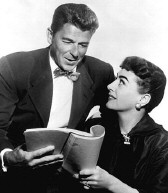 General
Electric Theater. Joan made 3 appearances on this CBS program hosted by
Ronald Reagan: "Road to Edinburgh" (10/31/54), "Strange Witness"
(3/23/58), "And One Was Loyal" (1/4/59).
General
Electric Theater. Joan made 3 appearances on this CBS program hosted by
Ronald Reagan: "Road to Edinburgh" (10/31/54), "Strange Witness"
(3/23/58), "And One Was Loyal" (1/4/59).
 Gilbert, John. (7/10/1899
- 1/9/1936)
Born John Cecil Pringle, the hard-drinking
Gilbert was
a huge, ultimately tragic, silent star, best known for his MGM film pairings (and
off-screen romance) with Greta Garbo.
He appeared with Joan in Twelve Miles Out (1927), Four
Walls (1928), and The Hollywood Revue of
1929.
Gilbert, John. (7/10/1899
- 1/9/1936)
Born John Cecil Pringle, the hard-drinking
Gilbert was
a huge, ultimately tragic, silent star, best known for his MGM film pairings (and
off-screen romance) with Greta Garbo.
He appeared with Joan in Twelve Miles Out (1927), Four
Walls (1928), and The Hollywood Revue of
1929.
A crew member on the set of Four Walls said:
The kisses shared by Crawford and Gilbert were sizzling. We all knew it and were rooting for her not only as a dramatic actress but to rival Garbo, who was ruining Gilbert's life. We thought Joan was clever enough to be discreet if Jack were led properly. He hadn't been happier in a long time. Though he and Joan couldn't get enough of each other when the camera was rolling, he didn't follow through. (CM)
Said Joan about their relationship:
Our chemistry on-screen may have been pretty hot--let's face it, as a couple we were pure sex, I think the first time that ever really came across with one of my leading men--but there was nothing face-to-face, person-to-person, when the scene was over. To be honest about it, Jack seemed too flibbertigibbety intense for my taste. I don't mean he was in any way effeminate--indeed, he was "all man." But he never stayed put, so to speak, you never felt he was giving you his entire attention. Oh, he was in love with Garbo, yes, at the time, but it was something else, too. I think it was narcissism. He seemed to be mostly in love with himself, with the effect he was producing. I used to feel sorry for him because he didn't have a mirror--a big one--handy to catch his every mood and look. I for one wanted a man who gave me his complete attention. Maybe Greta got that--I certainly didn't! (EB)
IMDb info. Golden Silents page. Wikipedia page.
 Gilmore,
Douglas (6/25/1903 - 7/26/1950)
Gilmore,
Douglas (6/25/1903 - 7/26/1950)
Born Harris Augustin Gilmore in Iowa, Gilmore appeared with Joan in three silents: Sally, Irene and Mary (1925), Paris (1926), and The Taxi Dancer (1927). (Pictured at left: On the set of Sally; a shot that appeared in fan mags publicizing the couple's dancing skills.)
After 21
films in his brief 7-year Hollywood career ('25-'31), Gilmore sporadically
took on stage work, appearing in 8 plays from 1931 through 1943
(with a 7-year gap between '33 and '40). His last credit is a 5-day
run in an unsuccessful 1943 revival
of Susan and God
(originally a hit 1937 play, then a 1940 Joan movie).
In
Joan Crawford: The Essential Biography, author Quirk quotes
Joan re Gilmore: "He was a handsome lug, and a good actor,
and he deserved a longer career than fate gave him."
[Editor's
Note: Which begs the question, not currently answered online: What
was Gilmore's problem? Was he an alcoholic or a drug addict? He
died at age 47 and didn't sustain a career either in Hollywood or
on Broadway. His first two of three marriages -- to actresses Gladys
Frazin and Ruth Mix -- lasted under a year each.]
IMDb page. Wikipedia page. IBDb page. Find a Grave page.
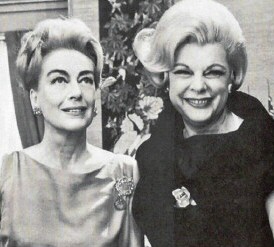 Girl
Talk. Syndicated talk show hosted by Virginia Graham from
1963 to 1969. According to the IMDb,
Joan appeared on the program 8 times:
Girl
Talk. Syndicated talk show hosted by Virginia Graham from
1963 to 1969. According to the IMDb,
Joan appeared on the program 8 times:
May 14, 1965; April 20,
1966; August 28, 1966; February 8, 1967; April 7, 1967; April 27,
1967; April 12, 1968; and November 1, 1969.
Virginia Graham Wikipedia page.
 Golden
Globes. Awarded by the Hollywood Foreign Press Association since 1944 for
excellence in film and television, both domestic and foreign.
Golden
Globes. Awarded by the Hollywood Foreign Press Association since 1944 for
excellence in film and television, both domestic and foreign.
Joan was nominated for 3 Golden Globes: In 1952 for Best Actress in Sudden Fear; and in 1954 and 1969 for the Cecil B. DeMille Award. She received the DeMille award on February 3, 1970, for the year 1969.
See this
site's Awards
page
for a close-up of her Golden Globe and more info.
See also the
main Golden
Globes site page for Joan,
and the Ready for My deMille: Profiles in Excellence-Joan Crawford, 1970
GG
page.
 Goodbye
My Fancy. Warners, 1951. Directed by Vincent Sherman, 107 minutes. Joan
stars as congresswoman "Agatha Reed," who returns to her alma mater
and rehashes an old college fling in the middle of some political turmoil. Also starring Robert Young, Frank Lovejoy,
and Eve Arden. Says Joan in CWJC: When
I first read the script I thought Warner was offering me the picture because
he couldn't get either Kate Hepburn or Roz Russell for the part. I still think
they could have done this sort of sophisticated political comedy better than
I did. But Vince Sherman, the director, made sure I did a pretty good job. All
the credit for bringing it off belongs to him.
Goodbye
My Fancy. Warners, 1951. Directed by Vincent Sherman, 107 minutes. Joan
stars as congresswoman "Agatha Reed," who returns to her alma mater
and rehashes an old college fling in the middle of some political turmoil. Also starring Robert Young, Frank Lovejoy,
and Eve Arden. Says Joan in CWJC: When
I first read the script I thought Warner was offering me the picture because
he couldn't get either Kate Hepburn or Roz Russell for the part. I still think
they could have done this sort of sophisticated political comedy better than
I did. But Vince Sherman, the director, made sure I did a pretty good job. All
the credit for bringing it off belongs to him.
Gordon, Annette. Neighbor of Joan's in New York City's Imperial House building. Gordon lived in apartment 23-G. In the early 70s, Joan wrote her the following note: Dear Mrs. Gordon. We are doing public service recordings and all we can hear is your daughter's yelling and tantrums. Is there no way you can control her? We would be so grateful if you would at least try. Why not try central park -- where she could draw a crowd?
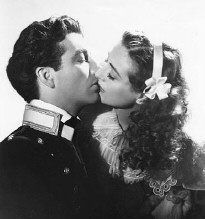 Gorgeous
Hussy, The. MGM, 1936. Directed by Clarence Brown, 105 minutes. Joan stars as innkeeper's
daughter "Peggy O'Neal"
in this period piece about President Andrew Jackson,
with an all-star cast including Robert Taylor, Lionel Barrymore, husband Franchot
Tone (her 5th film with him), Melvyn Douglas, and James Stewart. Says
Joan in CWJC: I wanted to do "Hussy,"
like a damned fool, and I did. Historical romance simply was not for me. A new
actor named Robert Taylor did a fine job, Franchot Tone and Melvyn Douglas and
another new actor named James Stewart were also good, but I was so totally miscast
I think this is where the term "credibility gap" originated.
Gorgeous
Hussy, The. MGM, 1936. Directed by Clarence Brown, 105 minutes. Joan stars as innkeeper's
daughter "Peggy O'Neal"
in this period piece about President Andrew Jackson,
with an all-star cast including Robert Taylor, Lionel Barrymore, husband Franchot
Tone (her 5th film with him), Melvyn Douglas, and James Stewart. Says
Joan in CWJC: I wanted to do "Hussy,"
like a damned fool, and I did. Historical romance simply was not for me. A new
actor named Robert Taylor did a fine job, Franchot Tone and Melvyn Douglas and
another new actor named James Stewart were also good, but I was so totally miscast
I think this is where the term "credibility gap" originated.
 Gough, Michael
(11/23/17
- ) Longtime British actor (debuting onscreen in 1947) who appeared with Joan in two films: Berserk! (1968) and
Trog (1970). He said
about Joan:
Gough, Michael
(11/23/17
- ) Longtime British actor (debuting onscreen in 1947) who appeared with Joan in two films: Berserk! (1968) and
Trog (1970). He said
about Joan:
I was in Joan Crawford's last two pictures...made in England. She was still a star here; she commanded respect and leading roles. Miss Crawford was every inch a star, yet despite the dozens and dozens of motion pictures she'd headlined, she still retained a vulnerability [and] a desire to please...In this country, we don't have, or at least didn't used to have [in the late sixties], the tendency to make jokes of older women or relegate them to the dustbin once they pass fifty.
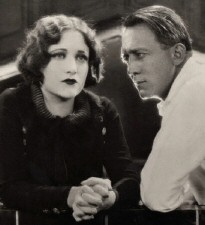 Goulding,
Edmund. (3/20/1891 - 12/24/59) Decadent British actor/playwright/director who directed
Joan in Sally,
Irene, and Mary;
Paris;
and Grand Hotel. One of four directors that Joan said really helped or influenced
her (the others: Clarence Brown, George Cukor, Mike Curtiz).
Goulding,
Edmund. (3/20/1891 - 12/24/59) Decadent British actor/playwright/director who directed
Joan in Sally,
Irene, and Mary;
Paris;
and Grand Hotel. One of four directors that Joan said really helped or influenced
her (the others: Clarence Brown, George Cukor, Mike Curtiz).
Said Joan in CWJC: Eddie Goulding was a mystery to me, but a pleasant one. He came on very strong sometimes, very self-effacing at other times, but he got what he wanted. Like Curtiz, much later, and Preminger, for that matter, I think he had a film running in his brain all the time he was shooting, and he wanted to duplicate that film, frame by frame, as it was shot. I always felt that he saw the completed picture before it was filmed.
altfg.com interview with Goulding biographer Silents Are Golden info IMDb info Wikipedia info
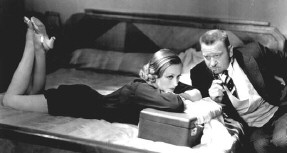 Grand
Hotel. MGM, 1932. Directed by Edmund Goulding, 115 minutes.
Grand
Hotel. MGM, 1932. Directed by Edmund Goulding, 115 minutes.
The
play Grand Hotel,
based on the German novel Menschen im Hotel, premiered on Broadway on
November 30, 1931, and ran for 257 performances. MGM contributed $15,000 to the
show in exchange for the film rights.
Joan plays
stenographer "Flaemmchen"
in an all-star cast also featuring Greta Garbo, John Barrymore, Lionel
Barrymore, Wallace Beery. Critical and popular consensus is that she more
than held her
own amid the heavyweights. If Our Dancing Daughters in '28 made
her a star, this one made her a... Superstar! This film
won Best Picture for 1932, Joan's only appearance in a movie that won the biggie. Says
Joan in CWJC: ...
my high point up 'til then. Little Joan was called upon to match Garbo, Wallace
Beery, and the Barrymores and she came off smelling like a rose. I adored that
film then and I do now. Goulding had a first-rate script and he made the most
of every scene, and Adrian dressed both Garbo and me exquisitely without putting
us out of character. God, what a picture!
Granlund, Nils T. A legend in New York City radio by 1924, when Joan met him backstage while she was appearing in "The Passing Show." Known as "NTG," he was considered the first DJ, the first Ed Sullivan; recordings were first broadcast on his show; and he pioneered the use of advertising to pay for air time. In addition to his talk and radio shows, he also packaged cabaret and floor shows, having 13 shows running in 1924 as well as owning some of the clubs he booked the shows into. (Barbara Stanwyck, Claire Luce, and Ruby Keeler were veterans of his shows.)
Early in 1924, Granlund and singer Harry Richman opened their speakeasy Club Richman, which became an upscale sensation. After their backstage meeting, Joan tearfully begged him for a job at the club, claiming a sick ma she had to care for; he hired her as a featured Charleston dancer for $50 a week and became her mentor-slash-sugar daddy, eventually introducing her to MGM's Marcus Loew and insisting he set up a screen test for her. When several screen tests were rejected by committee in MGM's California base, Granlund personally called Metro producer Harry Rapf and asked him to sign Joan. (JB)
 Grant,
Charles. Longtime Joan fan, and friend from 1960 until her death.
In the mid-1980s, he tried, unsuccessfully, to publish his autobiography
about his friendship with Joan: Unzip Me, Mr. Grant. He died
in the late '80s.
Grant,
Charles. Longtime Joan fan, and friend from 1960 until her death.
In the mid-1980s, he tried, unsuccessfully, to publish his autobiography
about his friendship with Joan: Unzip Me, Mr. Grant. He died
in the late '80s.
 Grauman's
Chinese Theater. Joan placed her hand- and footprints on the sidewalk
outside this Hollywood theater (located at 6925 Hollywood Blvd.) on September 14, 1929. This was also where the Oscar ceremonies were held in 1946, the year she won
the 1945 award for Best Actress. (Joan didn't attend, pleading illness.)
More
Grauman's info.
Grauman's
Chinese Theater. Joan placed her hand- and footprints on the sidewalk
outside this Hollywood theater (located at 6925 Hollywood Blvd.) on September 14, 1929. This was also where the Oscar ceremonies were held in 1946, the year she won
the 1945 award for Best Actress. (Joan didn't attend, pleading illness.)
More
Grauman's info.
 Gray, Gary.
(12/18/36 - )
Appeared with Joan in A Woman's Face (1941) as
"Sailor-Suited Boy in Park." In August 2001, Gray gave an interview
where he had this to say about Joan:
Gray, Gary.
(12/18/36 - )
Appeared with Joan in A Woman's Face (1941) as
"Sailor-Suited Boy in Park." In August 2001, Gray gave an interview
where he had this to say about Joan:
On one of my first movies I was a kid playing hopscotch in the park. I fell down and cut my knee. Before my own mother could get to me, Miss Crawford ran, picked me up, took me into her trailer, cleaned my cut and gave me some chocolate. She did all this without publicizing it or telling anyone. I don't care what anyone says, she had to have had a decent side to her to do what she did for me for no reason other than to help a child who was hurt. Besides, she was dead when that book was written. She wasn't around to defend herself.
 Great Day!
A Harry Beaumont-directed MGM musical starring Joan initially set for release in 1931; production
started in the fall
of 1930, but after around 8 weeks of shooting, the film was scrapped at considerable cost to the studio ($280,000
according to Joan and US),
largely due to Joan's extreme unhappiness with her southern belle performance
("I just can't talk baby talk," Joan told LB Mayer after viewing the
rushes, which she thought were "God-awful.") Another effort was made
to make the film in 1934, this time starring Jeanette MacDonald, but this also
fell through.
Great Day!
A Harry Beaumont-directed MGM musical starring Joan initially set for release in 1931; production
started in the fall
of 1930, but after around 8 weeks of shooting, the film was scrapped at considerable cost to the studio ($280,000
according to Joan and US),
largely due to Joan's extreme unhappiness with her southern belle performance
("I just can't talk baby talk," Joan told LB Mayer after viewing the
rushes, which she thought were "God-awful.") Another effort was made
to make the film in 1934, this time starring Jeanette MacDonald, but this also
fell through.
Great Day page (includes 2002 essay by Sandy McLendon on why the film not released)
 Grey,
Virginia. (3/22/1917 - 7/31/2004) Grey appeared with Joan as Crystal Allen's
charmingly catty co-worker in 1939's The Women. (She also spoke about
Joan in the 2002 TCM Joan doc "The Ultimate Star"; the two had remained
friends over the decades, corresponding fairly regularly until Joan's 1977 death.)
Born to a show-biz family, Grey debuted as a child star in 1927's Uncle
Tom's Cabin and went on to appear, mainly in supporting roles, in over
100 films as well as more than 40 TV shows, before retiring in the early
1970s. Her biggest year was probably 1939: aside from The Women, she
also appeared that year in Idiot's Delight and Another Thin Man.
IMDb
info.
Grey,
Virginia. (3/22/1917 - 7/31/2004) Grey appeared with Joan as Crystal Allen's
charmingly catty co-worker in 1939's The Women. (She also spoke about
Joan in the 2002 TCM Joan doc "The Ultimate Star"; the two had remained
friends over the decades, corresponding fairly regularly until Joan's 1977 death.)
Born to a show-biz family, Grey debuted as a child star in 1927's Uncle
Tom's Cabin and went on to appear, mainly in supporting roles, in over
100 films as well as more than 40 TV shows, before retiring in the early
1970s. Her biggest year was probably 1939: aside from The Women, she
also appeared that year in Idiot's Delight and Another Thin Man.
IMDb
info.
Griffin, Merv. Joan appeared on the U.S. program The Merv Griffin Show at least 16 times, according to the IMDb: 3/7/63, 7/19/65, 11/10/65, 11/16/65, 3/9/66, 4/5/66, 4/26/66, 6/28/67, 9/11/67, 2/27/68, 5/6/68, 11/4/69, 1/16/70, 3/21/70, 10/28/71, and 9/26/72.
